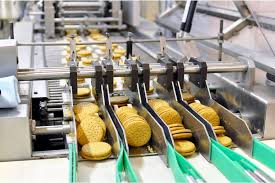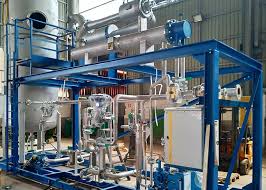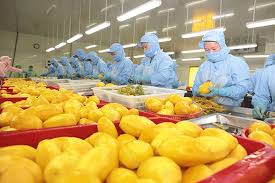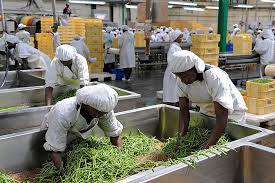Agro-processing industries play a crucial role in transforming raw agricultural products into value-added goods. This sector enhances the economic viability of agriculture by creating jobs, improving food security, and contributing to national economies.
Agro-processing involves the conversion of raw agricultural materials into consumable products. It encompasses a wide range of industries that add value to agricultural produce. Here are some key aspects of agro-processing industries:
1. Value Addition: By processing raw materials, these industries increase the market value of agricultural products, benefiting farmers and consumers.
2. Job Creation: Agro-processing industries provide employment opportunities in rural and urban areas, contributing to economic development.
3. Food Security: Processing helps reduce food waste and ensures a stable supply of food products, enhancing food security in communities.
4. Innovation: The sector drives technological advancements, leading to improved processing techniques and product development.
5. Sustainability: Agro-processing industries can promote sustainable practices by minimizing waste and utilizing by-products effectively
Food Processing Industries

Food processing industries transform raw agricultural products into safe, consumable foods. This sector includes a variety of processes and techniques:
1. Types of Processing: Food processing can involve canning, freezing, drying, fermenting, and cooking, depending on the product.
2. Preservation Techniques: Methods like refrigeration and vacuum sealing help extend the shelf life of food products.
3. Product Development: Food processors innovate by creating new products, such as ready-to-eat meals and organic snacks, to meet consumer demand.
4. Quality Control: Ensuring food safety and quality through stringent standards and regulations is essential in food processing.
5. Economic Contribution: The food processing industry significantly contributes to GDP and provides numerous employment opportunities.
Beverage Processing Industries
Beverage processing industries focus on converting raw materials into drinks, including alcoholic and non-alcoholic beverages:
1. Types of Beverages: This industry encompasses soft drinks, juices, dairy beverages, tea, coffee, and alcoholic drinks like beer and wine.
2. Processing Techniques: Techniques used in beverage processing include fermentation, pasteurization, filtration, and carbonation.
3. Market Trends: The beverage industry continually adapts to consumer preferences, focusing on health-conscious options, such as low-calorie and organic drinks.
4. Branding and Marketing: Effective branding and marketing strategies are vital for beverage companies to compete in a crowded market.
5. Environmental Considerations: Many beverage companies are implementing sustainable practices, such as reducing water usage and minimizing packaging waste.
Read Also: Dragon Fruits: History, Nutrition, Health Benefits and Growing Guide
Oil and Fat Processing Industries

Oil and fat processing industries extract oils and fats from raw materials like seeds and fruits. Here’s how they operate:
1. Sources of Oils: Common sources include soybeans, sunflowers, olives, and coconuts, each offering different nutritional profiles.
2. Extraction Methods: Processes like cold pressing and solvent extraction are used to obtain oils from raw materials.
3. Refining Processes: Refined oils undergo processes to remove impurities, enhance flavor, and extend shelf life.
4. Product Range: The industry produces cooking oils, margarine, shortening, and specialty fats for various culinary applications.
5. Health Considerations: Increasing consumer awareness of healthy fats has led to a demand for oils with beneficial properties, such as omega-3 fatty acids.
Grain and Flour Milling Industries
Grain and flour milling industries convert grains into flour and other products. Key points include:
1. Types of Grains: Common grains processed include wheat, corn, rice, and barley, each with unique milling requirements.
2. Milling Processes: Techniques like grinding, sifting, and refining transform whole grains into flour and other products.
3. End Products: The milling industry produces various products, including flour, grits, cornmeal, and cereal products for consumer use.
4. Quality Control: Maintaining quality and safety standards is crucial in the grain and flour milling process.
5. Nutritional Aspects: Whole grain products are increasingly popular due to their health benefits, prompting milling industries to adapt their processes.
Meat and Poultry Processing Industries
Meat and poultry processing industries focus on transforming raw meat and poultry products into safe, consumable forms. Here are some key aspects of this industry:
1. Processing Techniques: Techniques include slaughtering, cutting, deboning, and packaging. These processes ensure meat is safe for consumption.
2. Preservation Methods: Common preservation methods include freezing, smoking, and curing, which help extend the shelf life of meat products.
3. Quality Control: Ensuring food safety through strict quality control measures is critical in this industry to prevent contamination and ensure compliance with health regulations.
4. Product Range: The industry produces various products, including fresh cuts, processed meats (like sausages and hot dogs), and ready-to-eat meals.
5. Sustainability Practices: Many companies are adopting sustainable practices, such as reducing waste and utilizing by-products, to minimize their environmental impact.
Dairy Processing Industries
Dairy processing industries convert milk into a wide variety of products. Here’s how they function:
1. Types of Dairy Products: Common products include milk, cheese, yogurt, butter, and ice cream, each requiring specific processing methods.
2. Processing Techniques: Techniques include pasteurization, homogenization, and fermentation, ensuring product safety and enhancing flavors.
3. Nutritional Value: Dairy products are an essential source of nutrients, such as calcium and protein, contributing to overall health.
4. Quality Control: Strict hygiene standards and quality checks are essential to maintain the safety and quality of dairy products.
5. Market Trends: The dairy industry is adapting to changing consumer preferences, focusing on organic and low-fat options to meet demand.
Read Also: The Anise Fruits: Economic Importance, Uses, and By-Products
Fruit and Vegetable Processing Industries

Fruit and vegetable processing industries focus on converting fresh produce into various products. Here are some key points:
1. Processing Methods: Common methods include canning, freezing, drying, and juicing, which preserve the nutritional value of fruits and vegetables.
2. Product Variety: The industry produces a wide range of products, including canned fruits, frozen vegetables, dried fruits, and juices.
3. Waste Management: Efficient waste management practices, such as utilizing by-products for animal feed or compost, help reduce environmental impact.
4. Nutritional Benefits: Processed fruits and vegetables retain essential vitamins and minerals, making them a convenient option for consumers.
5. Quality Standards: Ensuring product quality and safety through rigorous testing and compliance with food safety regulations is crucial in this industry.
Sugar Processing Industries
Sugar processing industries convert raw sugar cane and sugar beets into refined sugar. Here’s how this sector operates:
1. Raw Material Sources: Sugar cane and sugar beets are the primary raw materials, each undergoing specific extraction processes.
2. Processing Techniques: Techniques include crushing, boiling, and crystallization to separate sugar from impurities.
3. Product Range: The industry produces granulated sugar, powdered sugar, and liquid sugars, catering to various consumer needs.
4. Health Considerations: The industry faces challenges related to health concerns, leading to a demand for alternatives, such as natural sweeteners.
5. Sustainability Efforts: Many sugar processing companies are adopting sustainable farming practices and energy-efficient processes to minimize their environmental impact.
Textile and Fiber Processing Industries
Textile and fiber processing industries focus on transforming raw fibers into fabrics and other textile products. Here’s an overview:
1. Types of Fibers: Common raw materials include cotton, wool, silk, and synthetic fibers, each requiring specific processing methods.
2. Processing Steps: Key steps include spinning, weaving, dyeing, and finishing to create various textile products.
3. Product Range: The industry produces a wide range of products, including clothing, home textiles, and industrial fabrics.
4. Sustainability Practices: Increasing awareness of environmental issues has led to a demand for sustainable practices, such as using organic fibers and reducing water usage.
5. Market Trends: The textile industry is adapting to consumer preferences for eco-friendly and ethically produced products, influencing production methods.
Biomass and Bioenergy Processing Industries
1. Sources of Biomass: Biomass can be derived from agricultural residues, forestry by-products, and organic waste, making it a sustainable energy source.
2. Conversion Technologies: Common conversion methods include combustion, anaerobic digestion, and gasification, each producing different types of bioenergy, such as heat, electricity, or biofuels.
3. Environmental Benefits: Utilizing biomass reduces greenhouse gas emissions, promotes waste management, and helps mitigate climate change impacts.
4. Economic Opportunities: The biomass sector creates job opportunities in rural areas and supports local economies through energy production and resource utilization.
5. Challenges: Despite its benefits, biomass energy faces challenges like supply chain issues, competition for land use, and the need for technological advancements.
Fish and Seafood Processing Industries
1. Processing Techniques: Common methods include cleaning, filleting, smoking, freezing, and canning, ensuring products are safe for consumption.
2. Product Variety: The industry produces a wide range of products, including fresh fish fillets, canned seafood, frozen shrimp, and fish meal.
3. Nutritional Value: Fish and seafood are rich in essential nutrients, including omega-3 fatty acids, making them a vital part of a healthy diet.
4. Quality Control: Strict quality control measures are essential to maintain food safety and ensure compliance with health regulations.
5. Sustainability Practices: The industry faces sustainability challenges, leading to increased interest in aquaculture and responsible sourcing practices.
Packaging and Labeling in Agro-Processing
1. Product Protection: Packaging protects products from damage, contamination, and spoilage during storage and transportation.
2. Consumer Information: Clear labeling provides essential information to consumers, including ingredients, nutritional value, and expiration dates.
3. Marketing Strategy: Attractive packaging enhances product appeal and can influence consumer purchasing decisions.
4. Regulatory Compliance: Compliance with labeling regulations is crucial for market access and consumer trust.
5. Sustainability Considerations: The industry is moving towards eco-friendly packaging options, reducing plastic waste, and utilizing biodegradable materials.
Challenges Faced by Agro-Processing Industries
1. Market Competition: Increased competition from local and international producers can affect pricing and market share.
2. Supply Chain Disruptions: Disruptions in supply chains due to natural disasters, pandemics, or geopolitical factors can impact production and distribution.
3. Technological Adoption: Many agro-processing industries face challenges in adopting new technologies, affecting productivity and efficiency.
4. Regulatory Compliance: Navigating complex regulations and standards can be challenging and costly for producers.
5. Sustainability Issues: Balancing profitability with sustainable practices is essential, but many industries struggle with implementing eco-friendly processes.
Do you have any questions, suggestions, or contributions? If so, please feel free to use the comment box below to share your thoughts. We also encourage you to kindly share this information with others who might benefit from it. Since we can’t reach everyone at once, we truly appreciate your help in spreading the word. Thank you so much for your support and for sharing!
Read Also: Chicken Brooder House – Complete Chicks Brooding Care Guide
Frequently Asked Questions
We will update this section soon.

